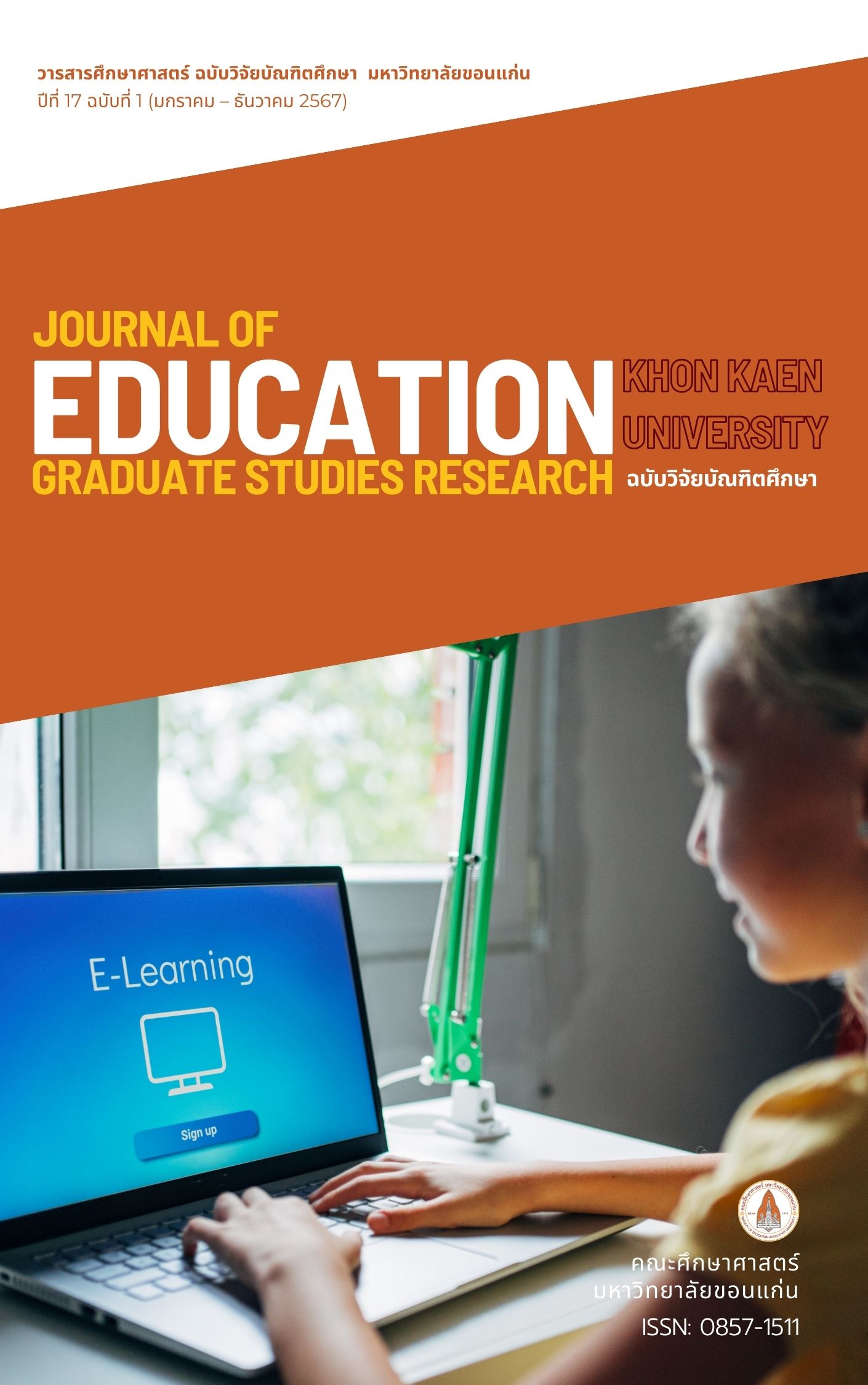The Relationship between Instructional Leadership of School Administrators and Teaching Behavior in The 21st Century of Teachers in Schools under The Secondary Educational Service Area Office Songkhla Satun
Main Article Content
Abstract
The objectives of this research were to: 1) study the teaching leadership of school administrators 2) study teaching behavior in the 21st century of teachers 3) study the relationship between teaching leadership of school administrators and teaching behavior in the 21st century of teachers in schools under the secondary educational service area office Songkhla Satun. The sample consisted of 346 teachers in schools under the secondary educational service area office Songkhla Satun. The samples were stratified random sampling. The research tool, general information of the respondents, a questionnaire about instructional leadership of school administrators and teaching behavior in the 21st century of teachers, had a reliability of .91 and .94. The data were analyzed by using frequency, percentage, mean, standard deviation, and Pearson’s product moment correlation coefficient. The research found that: 1) Instructional leadership of school administrators under the secondary educational service area office Songkhla Satun, the overall average was at the high level. 2) Teaching behavior in the 21st century of teachers in schools under the secondary educational service area office Songkhla Satun, the overall average was at the high level. 3) The relationship between instructional leadership of school administrators was positive with teaching behavior in the 21st century of school teachersand statistically significant at the .01 level. School administrators with instructional leadership will be able to improve the teaching behavior in the 21st century of teachers in schools.
Article Details

This work is licensed under a Creative Commons Attribution-NonCommercial-NoDerivatives 4.0 International License.
References
โกวิท บุญด้วง, กฤษณะ ดาราเรือง และสมศักดิ์ สุภิรักษ์. (2564). ภาวะผู้นำทางวิชาการของผู้บริหารสถานศึกษาที่ส่งผลต่อแรงจูงใจในการปฏิบัติงานของครูและบุคลากรทางการศึกษา สังกัดอาชีวศึกษาจังหวัดนครสวรรค์. วารสารวิจัยวิชาการ มหาวิทยาลัยเจ้าพระยา, 4(3), 125-135.
จินดา ลาโพธิ์. (2563). พฤติกรรมการสอนของครูกับการเรียนรู้ของผู้เรียน. วารสารมหาจุฬานา ครทรรศน์ มหาวิทยาลัยราชภัฏสกลนคร, 7(5), 36-43.
ชูศรี วงศ์รัตนะ. (2552). เทคนิคการใช้สถิติเพื่อการวิจัย ฉบับปรับปรุง. (พิมพ์ครั้งที่ 11). กรุงเทพฯ: ไทเนรมิตกิจ อินเตอร์ โปรเกรสซิฟ.
เชาวลิตย์ ชูจันทร์. (2559). ความสัมพันธ์ระหว่างภาวะผู้นําทางวิชาการของผู้บริหารโรงเรียนกับผลทดสอบทางการศึกษา ระดับชาติขั้นพื้นฐาน สังกัดสำนักงานเขตพื้นที่การศึกษาประถมศึกษาสระแก้ว เขต 1. (วิทยานิพนธ์ปริญญามหาบัณฑิต ไม่ได้ตีพิมพ์). มหาวิทยาลัยบูรพา, ชลบุรี.
ถนอมพร เลาหจรัสแสง. (2550). การเรียนรู้ในยุคสมัยหน้า ตอนรูปแบบและทฤษฎีการเรียนรู้อนาคต. สืบค้นจาก http://thanompo.edu.cmu.ac.th/load/journal/50-51/next-generation%20of%20learning.pdf
ทิศนา แขมมณี. (2556). ศาสตร์การสอน: องค์ความรู้เพื่อจัดกระบวนการเรียนรู้ที่มีประสิทธิภาพ. กรุงเทพฯ: สำนักพิมพ์แห่งจุฬาลงกรณ์มหาวิทยาลัย.
บรรพต รู้เจนทร์ และวัลลภา อารีรัตน์. (2558). ภาวะผู้นําาทางการเรียนการสอนของผู้บริหารสถานศึกษาที่ส่งผลต่อสมรรถนะครูในสถานศึกษาสังกัดองค์การบริหารส่วนจังหวัดนครราชสีมา. วารสารศึกษาศาสตร์ มหาวิทยาลัยขอนแก่น, 38(2), 150-156.
บุญชม ศรีสะอาด. (2556). วิธีการทางสถิติสำหรับการวิจัย เล่ม 1. (พิมพ์ครั้งที่ 5). กรุงทพฯ: สุวีริยา สาส์น.
ปวีณา เมืองมูล. (2561). การศึกษาพฤติกรรมการสอนของนักศึกษาฝึกประสบการณ์วิชาชีพครู สาขาวิชาการสอนภาษาอังกฤษ คณะครุศาสตร์ มหาวิทยาลัยราชภัฏราชนครินทร์. (ปริญญานิพนธ์มหาบัณฑิต ไม่ได้ตีพิมพ์). มหาวิทยาลัยราชภัฏราชนครินทร์, ฉะเชิงเทรา.
ปุณยา จันทมาตย์. (2557). การศึกษาทักษะการสอนของครูสังคมศึกษาเพื่อการเรียนรู้ในศตวรรษที่ 21 ในโรงเรียนมาตรฐานสากลระดับมัธยมศึกษา. (ปริญญานิพนธ์มหาบัณฑิต ไม่ได้ตีพิมพ์). จุฬาลงกรณ์มหาวิทยาลัย, กรุงเทพมหานคร.
พนมนคร มีราคา. (2560). ครูต้องมีลักษณะอย่างไร...ในศตวรรษที่ 21. คณะศึกษาศาสตร์ มหาวิทยาลัยมหามกุฏราชวิทยาลัย, 5(2), 23-34.
พิณสุดา สิริธรังศรี. (2557). การศึกษารากฐานการจัดการศึกษาแบบมีส่วนร่วม: แนวคิดสู่การปฏิบัติ. กรุงเทพมหานคร: มหาวิทยาลัยธุรกิจบัณฑิตย์.
เมตตา สอนเสนา และวัลลภา อารีรัตน์. (2558). ภาวะผู้นำทางการเรียนการสอนของผู้บริหารสถานศึกษาที่ส่งผลต่อแรงจูงใจในการปฏิบัติงานของครูในโรงเรียน สังกัดสำนักงานเขตพื้นที่การศึกษามัธยมศึกษา เขต 25. (วิทยานิพนธ์ปริญญามหาบัณฑิต ไม่ได้ตีพิมพ์). มหาวิทยาลัยขอนแก่น, ขอนแก่น.
รัตนา ดวงแก้ว. (2561). หน่วยที่ 13 ภาวะผู้นำการเรียนการสอน. ในประมวลสาระชุดวิชา นวัตกรรมการบริหารการศึกษาและภาวะผู้นำ หน่วยที่ 8-15 (พิมพ์ครั้งที่ 2, น. 3-18). นนทบุรี: สาขาวิชาศึกษาศาสตร์ มหาวิทยาลัยสุโขทัยธรรมาธิราช.
ละอองดาว ปะโพธิง. (2556). ความสัมพันธ์ระหว่างภาวะผู้นำทางวิชาการของผู้บริหารสถานศึกษากับพฤติกรรมการสอนที่มีประสิทธิผลของครูในสถานศึกษาระดับมัธยมศึกษา สังกัดสำนักงานเขตพื้นที่การศึกษามัธยมศึกษา จังหวัดเลย. วารสารวิจัยและพัฒนามหาวิทยาลัยราชภัฏเลย, 8(25), 1-13.
วันเผด็จ มีชัย, วัลลภา อารีรัตน์ และประกฤติยา ทักษิโณ. (2554). ภาวะผู้นำทางวิชาการที่ส่งผลต่อการบริหารงานวิชาการในโรงเรียน สังกัดองค์การบริหารส่วนจังหวัดขอนแก่น. วารสาศึกษาศาสตร์ ฉบับวิจัยบัณฑิตศึกษา มหาวิทยาลัยขอนแก่น, 5(2), 79-85.
สมถวิล ศิลปคนธรรพ์ (2556). ภาวะผู้นำทางวิชาการของผู้บริหารที่ส่งผลต่อการเป็นองค์กรแห่งการ เรียนรู้ในสถานศึกษาขั้นพื้นฐาน สังกัดสำนักงานเขตพื้นที่การศึกษาประถมศึกษาสมุทรสาคร. (วิทยานิพนธ์ปริญญามหาบัณฑิต ไม่ได้ตีพิมพ์). มหาวิทยาลัยศิลปากร, นครปฐม.
สำนักงานเขตพื้นที่การศึกษามัธยมศึกษาสงขลา สตูล. (2563). รายงานผลการดำเนินงาน ประจำปีงบประมาณ พ.ศ. 2563. สงขลา: สำนักงานเขตพื้นที่การศึกษามัธยมศึกษาสงขลา สตูล.
สำนักบริหารงานการมัธยมศึกษาตอนปลาย สำนักงานคณะกรรมการการศึกษาขั้นพื้นฐานกระทรวงศึกษาธิการ. (2558). แนวทางการจัดทักษะการเรียนรู้ในศตวรรษที่ 21 ที่เน้นสมรรถนะทางสาขาวิชาชีพ. กรุงเทพฯ: ชุมนุมสหกรณ์การเกษตรแห่งประเทศไทย.
สุกฤตา จันทคณานุรักษ์. (2560). ลักษณะครูที่ดีในศตวรรษที่ 21 และยุค Thailand 4.0. สืบค้นจาก http://www.kruinter.com/file/80820170917211151-[kruinter.com].pdf.
สุริยา ฆ้องเสนาะ. (2558). บทบาทของครูไทยในศตวรรษที่ 21. สืบค้นจาก https://drsumaibinbai.files.wordpress.com/2016/02/e0b89ae0b897e0b89ae0b8b2e0b897e0b882e0b8ade0b887e0b884e0b8a3e0b8b9e0b984e0b897e0b8a2e0b983e0 b899e0b8a8e0b895e0b8a7e0b8a3e0b8a3e0b8a9.pdf.
อุษา แซ่เตียว. (2559). ทักษะของผู้บริหารกับการบริหารงานวิชาการโรงเรียน สังกัดสำนักงานเขตพื้นที่การศึกษาประถมศึกษาสมุทรสงคราม. (วิทยานิพนธ์ปริญญามหาบัณฑิต ไม่ได้ตีพิมพ์). มหาวิทยาลัยศิลปากร, นครปฐม.
Alig-Mielcarek, J. M. and Hoy, W. K. (2005). A theoretical and empirical analysis of the nature, meaning, and influence of instructional leadership. The Ohio State University. Retrieved from http://72.14.235.104/search?q=cache:P2iwp AZ4GAwJ:www.coe.ohio-state.edu.
Darling-Hammond, L. (2006). Assessing teacher education the usefulness of multiple measures for assessing program outcomes. Journal of Teacher Education, 57(2), 120-138.
Fullan, M. (1991). The moral imperative of school leadership. Thousand Oaks: Corwin Press.
GoConqr, B. (2013, October 25). 10 Modern teaching skills. Retrieved from https://www.goconqr.com/en/examtime/blog/teaching-skills/
Hallinger, P. (2005). Instructional leadership and the school principal: A passing fancy that refuses to fade away. Leadership and Policy in Schools, 4(3), 221-239.
Hallinger, P. and Murphy, J. (1985). Assessing the instructional management behaviors of principals. The Elementary School Journal, 86(2), 217-247.
Janelle, C. (2019, November 1). 15 professional development skills for modern teachers. Retrieved from https://www.teachhub.com/15-professional-development-skills-modern-teachers.
Krejcie, R. V. & Morgan, D. W. (1970). Determining Sample Size for Research Activities. Educational and Psychological Measurement, 30(3), 607-610.
Krung, S.E. (1992). Instructional Leadership: A constructivist perspective. Educational Administration Quarterly, 28(3), 430-433.
Kyriacou, C. (2007) Improving the self-assessment skill for students of history education in Vietnam to adapt Vietnamese teaching standards. Hanoi National University of Education, 6(9), 1306-1310.
Lee Watanabe-Crockett. (2017). A list of 10 modern teaching skills every educator should have. Retrieved from https://globaldigitalcitizen.org/10-modern-teaching-skills
Linton, J. (2016, January 21). Instructional leadership that inspires innovation. Retrieved from http://corwin-connect.com/2016/01/instructional-leadership-that-inspires-innovation/
Ministry of Education, Guyana (n.d.). Importance of teaching skills in the classroom. Retrieved from https://education.gov.gy/web/index.php/teachers/tips-for-teaching/item/1870-importance-of-teaching-skills-in-the-classroom.
RAND Corporation. (2012). Teaching and learning 21st century skills. Retrieved from https://asiasociety.org/education/teaching-and-learning-21st-century-skills.
School Education Gateway. (n.d.). Teacher skills and competences. Retrieved from https://www.schooleducationgateway.eu/en/pub/resources/toolkitsforschools/subarea.cfm?sa=10.
Sisman, M. (2016). Factors related to instructional leadership perception and effect of instructional leadership on organizational variables: A meta-analysis. Fatih Sultan Mehmet Vakıf University, 16(5), pp.1761-1787.
Temesgen, Melaku. (1998). A study on principal's instructional leadership effectiveness and influencing factors in senior secondary schools of Amhara 139 region. (The Degree of Master of Arts in Educational Administration). Retrieved from http://213.55.95.56/handle/123456789/11612
The Maryland State Board of Education. (2005). Maryland instructional leadership framework. Retrieved from https://files.eric.ed.gov/fulltext/ED505848.pdf.
Timperley, H. (2011). Realizing the power of professional learning. New York: Open University Press.
University of Washington. (2015). 4 dimensions of instructional leadership. Retrieved from https://info.k-12leadership.org/hs-fs/hub/381270/file-2563776150-pdf/documents/tools/UWCEL-4D-Smart-Card-V2.0.pdf?hsCtaTracking=93f13f05-1fed-4b67-ae6a-0a69bdb1e2c7%7Ccf854e41-63f2-4648-bd9c-da7d32a5b8ad

